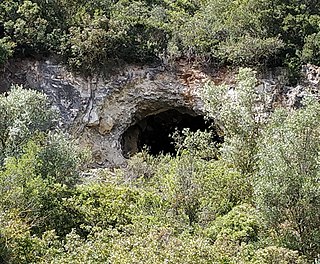 W
WAroeira 3 is a 400,000 year old Homo heidelbergensis hominid skull which was discovered in the Aroeira cave, Portugal. It is the earliest human trace in Portugal. H. heidelbergensis existed at the transition between Homo erectus and early Neanderthals and used both stone tools and fire. The skull was damaged during the 2014 excavation but was restored in the following two years. In 2017 the description of the skull was published in PNAS. It is on display in the National Archaeology Museum (Lisbon).
 W
WThe Cave of Aroeira is an archaeological and paleoanthropological site in the central limestone massif of the Portuguese Estremadura. The cave is located in the village of Almonda, in the civil parish of Zibreira, in the municipality of Torres Novas in the district of Santarém. The cave contained stones from the Paleolithic Acheulean culture, and the skull of Homo heidelbergensis, circa 400,000 years old. The discovery of Aroeira 3 was announced in spring 2017 - the earliest human trace in Portugal.
 W
WThe Prehistoric Rock-Art Site of Escoural Cave is a structure known for its Paleolithic-era rock-art and funerary burial site, located in the Portuguese municipality of Montemor-o-Novo, in the civil parish of Santiago do Escoural.
 W
WFurninha, also known as Dominique's cave, is a natural cave on the southern slope of the Peniche peninsula in Portugal. The cave is situated on the cliffs between the Peniche Fortress and the Cape Carvoeiro. The cave is located furthest west of any Neanderthal site. Neanderthals became extinct over 40,000 years ago. The cave was also inhabited by modern humans during the Neolithic.
 W
WThe Moinhos Velhos Cave, is one of the most important cave systems known in the Portuguese Maciço Calcário Estremenho, with about 9 km in extension. It is characterized by the existence of two fóssil paragenetic main conduits of about one decametre in diameter with dendritic tributaries, and a set of semi-active passages in a dendritic pattern at the north and angulate at the south. The fossil zone has a drop of 100 metres and the thickness of intermediate zone varies from 80 metres upstream to 60 metres downstream. Water flows in syngenetic galleries, from the northern to the southern quadrant, towards Gruta da Pena spring. It's possible to distinguish four genetic phases in the cave system development. The first one is represented by superficial phreatic galleries of small diameter, the second one by the Galeria Gémea paragenetic main conduit, the third one by the Galeria Grande and his tributaries and the last one by the active and semi-active galleries of the lower cave levels. This cave is inhabited by several endemic trogobionts: the ground-beetle Trechus lunai, the cave spider Nesticus lusitanicus and by several stygobionts, being the isopod Proaellus lusitanicus the most abundant.
 W
WThe Cave of Pedra Furada is a small cave located in the municipality of Vila Franca de Xira, about 20km north of Lisbon in Portugal. Archaeological studies conducted within the cave suggest it was occupied intermittently by humans during at least three periods between the end of the fourth millennium BC and the second millennium BC. The cave results from karstification of the limestone Upper Jurassic Massif.
 W
WThe Cave of Pego do Diabo is a small karst cave in a Turonian limestone outcrop located about 250 metres above sea level in the municipality of Loures, about 20 km north of Lisbon in Portugal. The erosion of the outcrop resulted in a set of openings in the rocks wide enough to be exploited by humans. Several archaeological studies have been conducted within the cave, which give insights into the duration of Neanderthal presence on the Iberian Peninsula and to the presence of carnivorous animals during the Paleolithic.
 W
WThe Cave of Salemas is located close to the village of Lousa in the municipality of Loures in the Lisbon District of Portugal. Discovered by archaeologists during the 1950s, the cave appears to have been occupied by humans as a temporary refuge during the Upper Paleolithic and used as a tomb during the Neolithic.